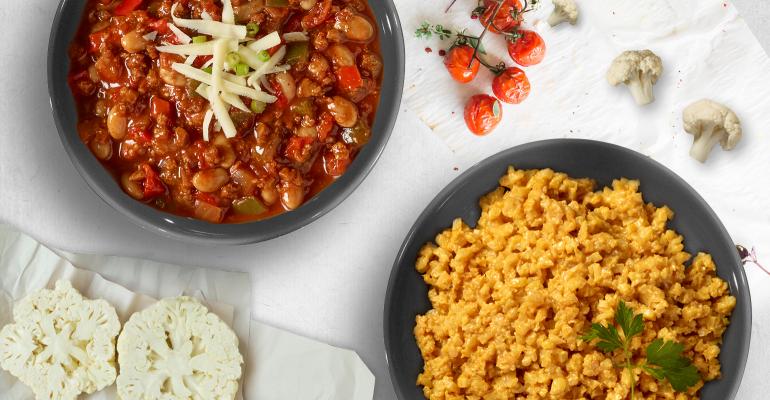Sponsored by Blount Fine Foods
Today's savvy foodservice operators and suppliers recognize that plant-forward dining is not just a passing fad. It's a permanent trend that promises to change the way many Americans eat.
“We’re treating it as a diet that's here to stay,” says Jeff Wirtz, culinary director of Blount Fine Foods.
Plant-forward refers to a style of food preparation and eating that emphasizes and celebrates fruits and vegetables, whole grains, beans, soy, nuts, and herbs and spices. The trend is attractive to consumers who are looking for innovative menu items that taste good and are healthful as well.
However while taste ranks high for consumers, convenience is also an important factor for operators. Blount guarantees both, Wirtz says.
“We’ve seen the movement coming up for a couple of years, so we knew our customers would start asking for it. We’ve been working for a while to find which products work best for our process,” he explains.
The Plant-Forward Trend
The plant-forward trend has primarily been driven by millennials and Gen Zs who are looking to reduce the amount of protein they consume for health reasons. But here’s the key—these consumers do not want to give up meat entirely.
This consumer group is known as “flexitarians” as opposed to vegans or vegetarians. Flexitarians want to eat more healthfully but don’t want to give up meat entirely. Vegans and vegetarians, on the other hand, choose to omit animal protein from their diet entirely.
Since pursuing a plant-forward regimen places less emphasis on eating animal protein, the protein space on the plate is often reduced. Some refer to this as making meat the condiment.
The Convenience Factor
While taste is always a critical factor in the dining-out experience, operators with their eye on kitchen operations regard convenience as a top priority, Wirtz says. Blount’s competitive edge as a prepared foods manufacturer is the fact that everything is fully cooked and ready to heat.
Operators don't have to add anything to Blount menu items that have been developed in the company's research kitchens. “It’s also a 100-percent yield,” Wirtz says. “Convenience has always been a focus of ours. It’s about taking that convenience and applying it to trends.”
Most operators want to feature items on their menus that satisfy their customers'’ demand for on-trend foods. Offering flavorful, ready-to-heat products that meet this need allow operators to accomplish the goal without complicating production in the kitchen.
Consumers Respond to Taste
Remember your mother saying, “Eat your vegetables. They're good for you?” Eating plant-forward foods is the grown-up response to that admonition.
The prime motivator for consuming plant-forward fare is the desire to improve health, but taste is still No. 1 for making these foods central to flexitarians’ diet. “They won’t order it a second time if it doesn't taste good,” Wirtz observes.
While some operators look for exotic fare to populate their menus, it’s not necessary to create unfamiliar foods to satisfy this demand. It’s more about recreating familiar favorites like chilis, soups and casseroles, and making them plant-forward. Consumers don’t need to feel as though they are completely changing their eating habits. They are just improving old favorites.
Health and Environmental Factors
While taste ensures the long-term success of the trend, health and environmental factors cannot be ignored. Primary menu messaging will focus on flavor, but many diners will want to be informed about health and environmental benefits.
The American Heart Association lists the health benefits of decreasing the consumption of animal protein. Eating more plant-based foods will reduce the risk of:
- Heart disease
- Stroke
- Obesity
- High blood pressure
- High cholesterol
- Type 2 diabetes
- Many cancers.
As for the environment, according to statistics, livestock production creates 15 percent of greenhouse gases and take up to two-thirds of agricultural land. Cutting back on consumption of meat would reduce these figures and add to sustainability.
Blount’s Initial Plant-Forward Offering
“Our first project is a chili that uses soy-based crumbles instead of beef,” Wirtz says The texture is just like that of beef and the crumbles adapt to any added flavors, he adds.
“Every customer we’ve shown it to loves it. It’s been one of our best launches in the past couple of years,” he explains.
The chili was introduced to operators in January and has been getting rave reviews since.
Blount will conduct nationwide tasting panels to determine any regional flavor differences for its upcoming plant-forward offerings.
Wirtz points out that the company conducts the testing through the Blount Family Kitchen program, which focuses on their retail side of the business. However, the research results can guide the ingredients and flavors of their foodservice menu items as well.
Meanwhile, the culinary team is exploring menu items that could incorporate the soy-based crumbles into soups or stews or even a plant-based beef Stroganoff.
“We’re treating the plant-forward trend as a part of a diet that’s here to stay,” Wirtz says, adding, “It's not a fad. Consumers will incorporate it into their lifestyles.”





